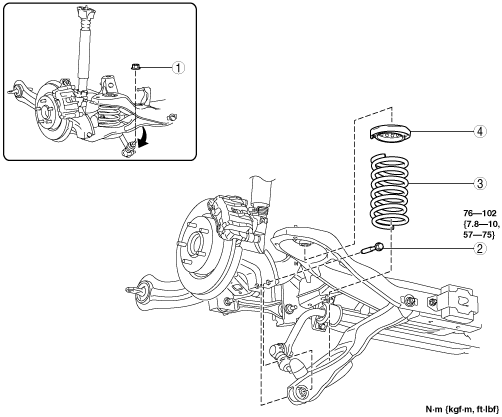 |
REAR COIL SPRING REMOVAL/INSTALLATION
id021400800700
1. Disconnect the auto leveling sensor lower side. (Vehicle with discharge headlight system) (See AUTO LEVELING SENSOR REMOVAL/INSTALLATION.)
2. Remove in the order indicated in the table.
3. Install in the reverse order of removal.
4. Inspect the wheel alignment and adjust it if necessary. (See REAR WHEEL ALIGNMENT.)
am3zzw00013259
|
|
1
|
Rear stabilizer control link upper side nut
|
|
2
|
Rear lower arm outer bolt
|
|
3
|
Rear coil spring
|
|
4
|
Upper spring seat rubber
|
Rear Stabilizer Control Link Upper Part Removal Note
1. Disconnect the rear stabilizer control link upper part.
2. Rotate the rear stabilizer as shown in the figure.
azzzcw00000089
|
Rear Lower Arm Outer Bolt Removal Note
1. Support the rear lower arm using a jack.
am3uuw00002836
|
2. Loosen the rear lower arm inner bolt.
3. Remove the rear lower arm outer bolt.
Rear Coil Spring Installation Note
1. Position the jack under the rear lower arm and jack up slowly.
am3uuw00002837
|
2. Align the upper end of the rear coil spring with the step of the upper spring seat rubber.
3. Align the lower end of the rear coil spring with the step of the lower spring seat rubber.
4. Install the rear lower arm outer bolt.
Rear Stabilizer Control Link Upper Side Nut Installation Note
1. Verify the shape of the removed nut and if it is an A type, replace the nut with a new one.
azzzcw00000090
|
2. Install and tighten the nut.
azzzcw00000090
|